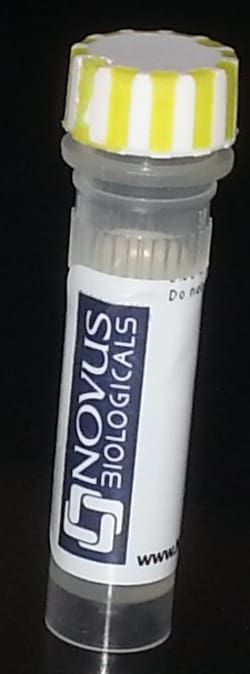Siglec-3/CD33 Antibody (WM53), PE/Atto594, Novus Biologicals™
Manufacturer: Novus Biologicals
Select a Size
| Pack Size | SKU | Availability | Price |
|---|---|---|---|
| Each of 1 | N234511P594-Each-of-1 | In Stock | ₹ 62,878.50 |
N234511P594 - Each of 1
In Stock
Quantity
1
Base Price: ₹ 62,878.50
GST (18%): ₹ 11,318.13
Total Price: ₹ 74,196.63
Antigen
Siglec-3/CD33
Classification
Monoclonal
Conjugate
PE/ATTO 594
Formulation
PBS with 0.05% Sodium Azide
Gene Symbols
CD33
Immunogen
Human AML cells
Quantity
0.1 mL
Primary or Secondary
Primary
Test Specificity
Recognizes a 67kDa glycoprotein, which is identified as CD33 (HLDA IV; WS Code M-505). CD33 is a transmembrane protein of the sialic acid-binding immunoglobulin-like lectin (Siglec) family. It belongs to the immuno-receptor tyrosine-based inhibitory motif (ITIM)-containing molecules able of recruiting protein tyrosine phosphatases SHP-1 and SHP-2 to signal assemblies; these ITIMs are also used for ubiquitin-mediated removal of the receptor from the cell surface. CD33 is expressed on cells of myelomonocytic lineage, binds sialic acid residues in N- and O-glycans on cell surfaces, and is a therapeutic target for acute myeloid leukemia. CD33 is expressed on myeloid progenitors, monocytes, granulocytes, dendritic cells and mast cells. It is absent on platelets, lymphocytes, erythrocytes and hematopoietic stem cells.
Content And Storage
Store at 4°C in the dark. Do not freeze.
Applications
Flow Cytometry
Clone
WM53
Dilution
Flow Cytometry
Gene Alias
CD33 antigen, CD33 antigen (gp67), CD33 molecule, FLJ00391, myeloid cell surface antigen CD33, p67, sialic acid binding Ig-like lectin 3, Sialic acid-binding Ig-like lectin 3, SIGLEC-3, SIGLEC3gp67
Host Species
Mouse
Purification Method
Protein A or G purified
Research Discipline
Immunology
Gene ID (Entrez)
945.0
Target Species
Human
Isotype
IgG1 κ
Description
- Siglec-3/CD33 Monoclonal specifically detects Siglec-3/CD33 in Human samples
- It is validated for Flow Cytometry.
